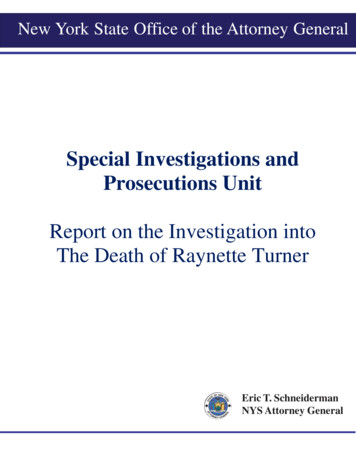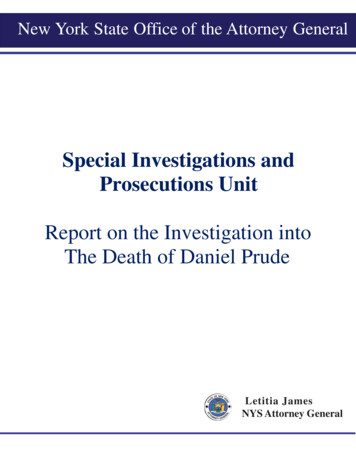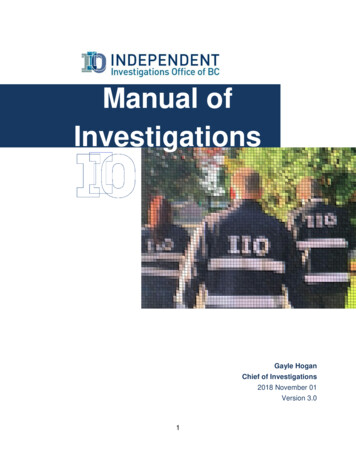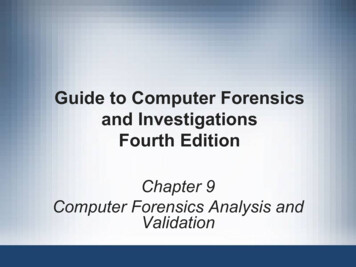
Transcription
New York State Office of the Attorney GeneralSpecial Investigations andProsecutions UnitReport on the Investigation intoThe Death of Raynette TurnerEric T. SchneidermanNYS Attorney General
EXECUTIVE SUMMARYOn July 8, 2015, Governor Andrew Cuomo signed Executive Order No. 147 (the“Executive Order”), appointing the Attorney General as a special prosecutor “to investigate, andif warranted, prosecute certain matters involving the death of an unarmed civilian . . . caused bya law enforcement officer.” On Saturday, July 25, 2015, Raynette Turner (“Ms. Turner”) wasarrested for two counts of petit larceny and taken to the Mount Vernon Police Department(“MVPD”). Approximately 48 hours later, the MVPD found Ms. Turner deceased in a holdingcell. On August 3, 2015, Governor Cuomo issued Executive Order No. 147.1, which expresslyconferred jurisdiction upon the Attorney General to investigate any potential unlawful acts oromissions relating to Ms. Turner’s death.Pursuant to Executive Orders No. 147 and 147.1, the Office of the Attorney General’s(“OAG”) investigation included, among other investigative steps: Review of the Westchester County Medical Examiner’s Office’s (“MedicalExaminer”) autopsy, microscopy, and toxicology records; Review of video footage from several MVPD videos depicting virtually the entireduration of Ms. Turner’s confinement at the MVPD, including video footage fromseveral different cameras monitoring the holding cells (“the Holding CellVideo”), the arrest processing area, the MVPD hallways, and the MVPD entranceor sally port (sometimes collectively referred to as “the Video”); Interviews of more than 40 witnesses including, among others, employees of theMVPD, court personnel, family and acquaintances of Ms. Turner, and arresteeswho were in the custody of the MVPD at the same time as Ms. Turner; and Review of more than 1,700 pages of Ms. Turner’s medical records before andduring her confinement at the MVPD.The OAG finds that MVPD employees did not cause Ms. Turner’s death. The MedicalExaminer’s records and the Video are the most salient evidence. The Medical Examiner foundno physical trauma suggesting any form of physical abuse by the MVPD. There is no indicationof any physical abuse on the Video, and none of the witnesses interviewed raised any suggestionof physical abuse. The Medical Examiner found that Ms. Turner’s death was caused by anenlarged heart, and that chronic cocaine and morphine use contributed to her death. Ms.Turner’s medical records prior to her arrest include records indicating drug use and chroniccardiac issues that corroborate the Medical Examiner’s findings.Under these circumstances, the only conceivable theory for a homicide prosecutionwould be that MVPD employees failed to provide necessary medical care to Ms. Turner and thatthis failure resulted in her death. The only possible homicide charge would be criminallynegligent homicide. For the reasons discussed below, no such charge is warranted in this case.1
The Video shows that MVPD officers checked on Ms. Turner through periodic, in-personvisits. Interviews of MVPD employees indicate that they also checked on her via a closed-circuitvideo monitor. While in custody, Ms. Turner made one request for medical attention – regardingher prescription medications – and MVPD employees promptly took her to a nearby hospitalwhere she received medication. Ms. Turner was arrested on a Saturday. The hospital visit wasSunday evening. After the hospital visit, on late Sunday and Monday, the Video shows that Ms.Turner appeared to vomit or retch on many occasions. MVPD employees continued to check onher periodically. For example, from 11:45 am to 2:11 pm, MVPD employees were present at ornear her cell approximately 10 times; during six of these visits the employees either interactedwith Ms. Turner directly or looked into her cell. On Monday, MVPD employees also inquiredabout Ms. Turner’s medical condition twice, and, in response, Ms. Turner did not requestadditional medical attention. Finally, when an MVPD employee discovered that Ms. Turner wasnonresponsive, emergency medical services (“EMS”) was contacted immediately.The standard necessary to sustain a charge of criminally negligent homicide is that adefendant failed to perceive a substantial and unjustifiable risk that a death would occur and thatthe failure to perceive that risk constituted a gross deviation from reasonable care. The OAGfinds no basis to conclude that any MVPD employee failed to perceive a substantial andunjustifiable risk that Ms. Turner’s death would occur or that any such failure to perceive thatrisk constituted a gross deviation from reasonable care.As described in detail below, however, state regulations required in-person cell visits ofMs. Turner at least every thirty minutes. The general practice at the MVPD at the time of Ms.Turner’s incarceration was to conduct cell visits by closed-circuit television and not by in-personvisits. MVPD employees readily acknowledged this practice during the OAG investigation. Weraised this issue with the MVPD, and the MVPD has advised us that they are now ensuring thatMVPD employees perform the required cell visits in person. While the failure to follow stateminimum standards required remediation by the MVPD, we do not believe that the MVPD’spractice caused its employees to fail to perceive a substantial and unjustifiable risk that Ms.Turner’s death would occur. The Holding Cell Video provides a direct view of the cells that Ms.Turner was in, and the use of the Holding Cell Video was supplemented by periodic, in-personvisits.***The following report details the OAG’s investigation and legal analysis. We also attachseveral exhibits to the report, including: (1) still photos from the Video (Exhibit A); (2) theMedical Examiner’s autopsy report (Exhibit B); and (3) copies of various MVPD policies andprocedures (Exhibits C).Executive Orders No. 147 and 147.1 also provide that the OAG may offer “anyrecommendations for systemic reform arising from the investigation.” The OAG’srecommendations cover two general issues. First, we recommend that policymakers address theneed to more swiftly bring arrestees before arraignment judges for consideration of bail andpossible release. Second, we recommend actions relating to detainee medical care, including thatthe New York State Commission of Correction (“COC”) review its minimum health care2
standards and provide more precise guidance regarding the circumstances under which agenciesshould seek medical attention for inmates. Law enforcement personnel are not physicians andwould benefit from clear standards regarding when to arrange for emergency medical care forarrestees.STATEMENT OF FACTS 1A.Ms. Turner’s Arrest and Detention by the MVPD1. Ms. Turner’s ArrestThe MVPD arrested Ms. Turner on the afternoon of Saturday, July 25, 2015 for thefts atRestaurant Depot and Target. Both thefts are captured on store surveillance footage. TheRestaurant Depot footage depicts a woman later identified to be Ms. Turner entering the storearound 12:25 pm and leaving the store two minutes later, bypassing the cash registers, andentering the parking lot with a box of crab legs under her left arm. Restaurant Depot personneldid not apprehend Ms. Turner. Around 12:30 pm, a manager at Restaurant Depot called 911 toreport the theft.The Target surveillance footage shows that, at approximately 1:00 pm, Ms. Turner placedtwo boxes of headphones into her bag and walked toward the entrance/exit doors where she wasstopped by security personnel. After being escorted to the Target Booking Room, Ms. Turnersigned an Admission Statement acknowledging that she had stolen electronics and accessoriesworth more than 600. One of the MVPD officers who responded recognized Ms. Turner fromthe prior Restaurant Depot surveillance video. The officer called the Restaurant Depot managerwho had called 911. The Restaurant Depot manager identified Ms. Turner as the person who hadstolen property from the Restaurant Depot approximately 90 minutes earlier.The OAG neither received nor uncovered any allegation, indication, or evidence ofwrongdoing by the MVPD officers in carrying out the arrest.2. Arrival at the MVPD and the MVPD Intake ProcessMs. Turner arrived at the MVPD at approximately 2:40 pm on July 25, 2015. (Exhibit Aat 1). MVPD employees placed her in the booking area and called her husband, Herman Turner,to notify him of the arrest.MVPD Procedure No. 3.067 (Prisoner Suicide Prevention Screening) requires that a NewYork State-certified MVPD Desk Officer screen each arrestee to identify and reduce the risk ofsuicide. (Exhibit C at 8). After the arrestee is screened, he or she is placed into one of threelevels of supervision: constant, active, or normal. Pursuant to Procedure No. 3.067, constantsupervision requires “uninterrupted personal visual observation of prisoners” 24 hours per day.(Exhibit C at 8). An arrestee is placed on constant supervision when he or she is believed to be asuicide risk. Active supervision requires “immediate availability to prisoners” and that1None of the information referenced in this report was obtained through the use of grand jury subpoenas. Anysubpoenas issued were pursuant to New York State Executive Law Section 63(8).3
“supervisory visits [are] conducted at a minimum of fifteen (15) minute intervals.” (Exhibit C at8). The MVPD member must be able to “communicate orally with prisoner[s] and respond [totheir inquiries].” (Exhibit C at 9). Normal supervision requires that the “condition” of a detaineebe checked “by actual visits to cells at intervals not to exceed thirty (30) minutes.” (Exhibits Cat 9). 2The on-duty Desk Officer, Sergeant Vincent Stufano, interviewed Ms. Turner andcompleted her “Suicide Prevention Screening Guidelines” form. During the screening process,an empty bottle of a benzodiazepine (which is used to treat panic disorders) was vouchered. Ms.Turner spoke about prior mental-health diagnoses and told Sgt. Stufano that she neededmedications that she had been prescribed relating to these diagnoses. She made no complaintsregarding her general health or physical condition. Ms. Turner also denied using or being underthe influence of non-prescription drugs. Based upon Ms. Turner’s final score on the screeningquestions and Sgt. Stefano’s overall assessment of her, he placed her on “active supervision”requiring supervisory visits every 15 minutes.In addition to implementing the “Suicide Prevention Screening Guidelines,” the DeskOfficer is responsible for supervising the detainee’s arrest processing. This includes determiningwhether the arrestee has any outstanding warrants and deciding whether “booking” or arrest isappropriate. Pursuant to MVPD procedure, when court is not in session, a Desk Officer also isauthorized to set pre-arraignment bail and issue a Desk Appearance Ticket (“DAT”), whichreleases the arrestee from police custody and directs the arrestee to appear in court on a specificdate and time. (Exhibit C at 4 - 5). 3 MVPD officers told us that, pursuant to MVPD procedure,before they issue a DAT, an arrestee must be fingerprinted and his or her record must be checkedfor outstanding warrants. 4 The Desk Officer may also consider the underlying facts of the caseas well as the arrestee’s criminal and bench warrant history.Based upon our interviews with the MVPD desk officers, Ms. Turner was not consideredfor the issuance of a DAT. In addition, Ms. Turner was not fingerprinted at the time of herarrest. Therefore, while some warrant information and criminal history were available to Sgt.2MVPD Procedure No. 3.067 is consistent with the New York State Minimum Standards and Regulations forManagement of City Jail – Town and Village Lockups (“State Minimum Standards”), which require that “thecondition of prisoners shall be checked, by actual visits to cells and detention rooms, at intervals not to exceed 30minutes.” 9 NYCRR § 7504.1(a) (emphasis added). Notwithstanding MVPD Procedure No. 3.067 and the StateMinimum Standards, the MVPD procedure defining detention protocols (Mount Vernon Police DepartmentDetention and Transportation Procedures – TC-1 2006 – 02/27/06) simply requires that employees “note prisoneractivity” every 15 or 30 minutes, without specifying that observations of prisoner activity must be based upon actualvisits. (Exhibit C at 2). As noted above, MVPD employees informed the OAG that they did their supervision visitsby observing prisoners via closed-circuit television. While the use of closed-circuit television to monitor detaineesis an appropriate adjunct to actual cell visits, it may not be used “as a substitute for such visits.” 9 NYCRR§ 7504.1(g).3MVPD Procedure No. 3.050 provides that (a) the Desk Officer shall “promptly” have fingerprinted any personeligible for a DAT and (b) no DAT “shall be issued until the prisoner has been fingerprinted and a record check foroutstanding warrants has been completed.” (Exhibit C at 5).4At the MVPD, arrestees can only be fingerprinted by individuals assigned to the Detective Bureau. Mondaythrough Friday, detectives assigned to the Criminal Investigations Unit (“CIU”) fingerprint all arrestees. Onweekends, arrestees are fingerprinted if and when a detective is available.4
Stufano, the complete, comprehensive, multi-state information supplied after fingerprintsubmission was not. MVPD officers indicated that, pursuant to MVPD practice, Ms. Turnerwould not have been actively considered for a DAT, because she had been arrested for twounrelated offenses in one day and the dollar value of the goods stolen exceeded 600. When Ms.Turner was ultimately fingerprinted, it was determined that she had a bench warrant history,aliases, a probation revocation, and multiple convictions, which MVPD employees advised uswould have caused them not to issue a DAT.3. Relocation to the Cell BlockPursuant to MVPD Policy Article XIX, prisoner attendants are generally responsible forthe “care and safekeeping” of detainees, serving meals and, if necessary, rendering first aid.(Exhibit C at 3). There are three prisoner attendant posts at the MVPD; attendants may beassigned to the first floor holding cells (“cell block”), the second floor holding cells, or as the“runner” who escorts arrestees between the cell block and the second floor holding cells. Bothlaw enforcement officers and civilian employees perform prisoner attendant functions.At approximately 3:00 pm, Ms. Turner was escorted from the booking area to the cellblock by Prisoner Attendant Carlo Jean-Baptiste and placed into cell number 31. (Exhibit A at2).Police Officer Bahiyah Morris was the attendant for the cell block from 4:00 pm tomidnight. At approximately 5:15 pm, Officer Morris served Ms. Turner dinner. According tothe Video, after eating dinner, Ms. Turner spent several hours lying down on a bench in her cell.During that period, she can also be seen intermittently standing, walking to the cell door, andsitting on the bench in the cell. Occasionally, while seated, Ms. Turner can be seen bendingforward or doubling over. This was a somewhat infrequent occurrence on the first day that Ms.Turner was detained, but it happened with greater frequency on the second and third days thatshe was detained.4. The Morning and Afternoon of Sunday, July 26, 2015According to the Video, from approximately midnight until 5:00 am, Ms. Turner wasasleep, lying on the cell bench and turning occasionally. At approximately 6:25 am, she sat upon the bench. She can also be seen rocking back and forth at that time. Prisoner Attendant JeanBaptiste worked the 8:00 am to 4:00 pm shift and provided Ms. Turner a sandwich and a drinkfor breakfast shortly after 8:00 am. Until about 4:00 pm, Ms. Turner was primarily lying down,but occasionally can be seen standing, eating, and doubling over while seated on the cell bench.Police Officer Ryan Hughes was assigned as an attendant from 4:00 pm to midnight. Atapproximately 4:05 pm, Ms. Turner asked him if she could call her husband. (Exhibit A at 3).Officer Hughes told her that she was not permitted to make a telephone call at that time, but as acourtesy, he offered to call her husband on her behalf. Ms. Turner provided Officer Hughes withthe telephone number, and at approximately 4:15 pm Officer Hughes called her husband,Herman Turner, to let him know that Ms. Turner was scheduled to have a court appearance onMonday.5
5. Montefiore Mount Vernon Hospital Visit on Sunday EveningAt approximately 4:40 pm, Ms. Turner told Officer Hughes that she had not had herhypertension medication in a few days, and she asked to go to the hospital to obtain thatmedication. Shortly thereafter, Officer Hughes called the front desk and reported that Ms.Turner needed her medication. At approximately 5:45 pm, Police Officer Michael Paulson andProbationary Police Officer (“PPO”) Nazeem Whipper escorted Ms. Turner from her cell to apolice car for transport to Montefiore Mount Vernon Hospital (“MMVH”), which isapproximately a tenth of a mile from the MVPD. (Exhibit A at 4). The Video shows that Ms.Turner walked without assistance to the transporting police car with Officer Paulson and PPOWhipper.They arrived at MMVH shortly thereafter and remained at the hospital untilapproximately 10:00 pm. According to the medical records, upon arrival Ms. Turner’s chiefcomplaint was “needs meds.” The medical records also state that Ms. Turner had“pain/discomfort” on the left side of her body, and the pain was rated a “7” on a scale of 0 to 10(with 10 being the highest level of pain). During her triage interview, Ms. Turner reported thatshe was at the hospital “for medication that she ha[d] not had from yesterday.” Ms. Turner wassubsequently taken to an examining room where, according to Officer Paulson and PPOWhipper, she indicated that she was hungry and was provided with food and a beverage.At the hospital, Ms. Turner met with nurses, a general physician, and a psychiatrist. Thetriage notes indicate: “revisit/miscellaneous medication refill . . . patient is in police custodyneeds to be medicated.” The hospital records indicate that she was currently being prescribeddrugs to treat hypertension, anxiety, and insomnia. She denied the use of alcohol or nonprescription drugs. Ms. Turner was designated as triage category “4” on a scale of 1-5 (1 is thehighest urgency level). 5 MMVH staff provided bridge medications 6 to Ms. Turner consistentwith those she had been receiving prior to her arrest, including blood pressure, anxiety, andinsomnia medications. In short, the drugs Ms. Turner received at MMVH were the same asthose that she was already being prescribed or generic preparations thereof. At approximately10:00 pm, Ms. Turner was discharged from MMVH. The hospital records state that hercondition was “stable.” Ms. Turner was provided with patient information on hypertension andinstructions to follow up with her primary care physician and psychiatrist upon her release fromcustody. MMVH did not give any specific instructions or warnings to the MVPD concerningMs. Turner’s continued care.Officer Paulson, PPO Whipper, and Ms. Turner returned to the MVPD at approximately10:00 pm. (Exhibit A at 5). Prisoner Attendant Brian Burrell was on duty at the time; he placedMs. Turner in cell number 29, because her original cell (number 31) was being cleaned. PrisonerAttendant Burrell then gave Ms. Turner a sandwich and a drink. After eating, Ms. Turner lay5See generally �Bridge medication” refers to a quantity of medication provided to an individual who would otherwise not haveaccess to his or her prescription(s), in order to carry that person to a time when regular access can resume.6
down on the bench in her cell. Between approximately 11:15 pm and midnight, Ms. Turnerappears to vomit or retch five to six times. 76. Fingerprinting Early Monday MorningThe Video shows that Police Officer Ian Yearwood and Detective Juliet Roach, membersof the MVPD Detective Division, escorted Ms. Turner from cell number 29 to the MVPDfingerprinting machine at approximately 2:15 am. (Exhibit A at 6). Ms. Turner returned to hercell at approximately 2:30 am. (Exhibit A at 7). According to the Video, she appears generallyto sleep during the rest of the night, but her sleep was interrupted at various times when she canbe seen awakening, leaning over the toilet, and vomiting or retching.7. Monday MorningPrisoner Attendant Burrell was assigned to the cell block during the 8:00 am to 4:00 pmshift. The Video indicates that between approximately 8:00 am and 8:20 am, Ms. Turner leanedover the toilet and vomited or retched several times. During that time period, Ms. Turner ishanded toilet paper, and a cup is left in the opening of her cell. (Exhibit A at 8).At 9:00 am, Prisoner Attendant Burrell began his assignment as a “runner,” takingarrestees back and forth between the first floor cell block (where Ms. Turner was) and theholding cells located on the second floor. At approximately the same time, Prisoner AttendantRicardo Atkinson began his 9:00 am to 5:00 pm shift and was assigned to the first floor cellblock. Prisoner Attendant Atkinson is a civilian MVPD employee and not a police officer.According to the Video, at approximately 9:35 am, Prisoner Attendant Michael Barnesescorted Ms. Turner from cell number 29 to an interview room where she was interviewed byMs. Lillian Mizell Harris, Program Assistant for Pre-Trial Services Institute of WestchesterCounty (“PTSI”). (Exhibit A at 9). PTSI is responsible for making recommendations to thecourt about whether arrestees should be released at arraignment. According to Harris, during thePTSI interview, Ms. Turner rubbed her stomach and said that she did not feel well. Ms. Turnerdid not request medical assistance, and Harris did not feel that Ms. Turner’s words or actionswere cause for concern. 8 Upon completion of the interview, Ms. Turner stood and walkedunassisted out of the interview room. After the PTSI interview, the Video shows that PrisonerAttendant Atkinson escorted Ms. Turner back to cell number 29. (Exhibit A at 10).7The Video does not clearly show whether Ms. Turner vomited at any particular point. This report refers tovomiting or retching in instances where it appears that she vomited or retched based upon her posture while leaningover the toilet.8Prior to the OAG’s interview of Ms. Harris on August 13, 2015, Ms. Harris told the press that Ms. Turner did notseem to Ms. Harris to have been seriously ill. See eaks/30903989/.7
8.Ms. Turner’s Return from a Court Holding Cell Due to IllnessAccording to the Video, at approximately 9:49 am, Prisoner Attendant Atkinson led Ms.Turner and three other female arrestees from the first floor cell block to the elevator. (Exhibit Aat 11). Prisoner Attendant Burrell escorted them onto the elevator and up to the court holdingcells on the second floor.According to the court holding cell Video, 9 the female detainees, including Ms. Turner,were escorted into the female court holding cell. Ms. Turner entered the cell, stood near thewall, and appeared to speak with Prisoner Attendant Burrell. According to him, Ms. Turnerasked if she could go back downstairs to her cell, because she did not feel well and wanted to liedown. This conversation was substantiated by one of the female arrestees in the court holdingcell. The Video shows that Prisoner Attendant Burrell escorted Ms. Turner out of the courtholding cell approximately one minute after she entered.Prisoner Attendant Burrell then walked Ms. Turner to the first floor, where they metPrisoner Attendant Atkinson. According to Prisoner Attendant Burrell, during this time he askedMs. Turner how she was feeling and she replied “a little better.” According to the Video, atapproximately 9:52 am (three minutes after she had been escorted out of cell number 29).Prisoner Attendant Atkinson escorted Ms. Turner to cell number 23. (Exhibit A at 12). Ms.Turner walked unassisted to and from the court holding cell. According to Prisoner AttendantAtkinson, he asked Ms. Turner if she was okay and she replied, “Yes, I just want to lie down.” 10The Video next shows that, between approximately 9:52 am and 10:37 am, Ms. Turnerleaned over the toilet six times. At least twice during that time she appeared to place her fingersin her mouth and vomit or retch. At approximately 10:55 am, Prisoner Attendant Atkinson leftfood and a drink for Ms. Turner in the opening of the door of cell number 23 (Exhibit A at 13).9There is a time difference of approximately ten minutes between the video recordings from the jail cells on thefirst floor and the video recordings from the court holding cells on the second floor. According to StrategemSecurity (the company that installed the video surveillance cameras at the MVPD), various cameras throughout theMVPD are connected to one of several servers, and all cameras on a given server are time-stamped to that server’sinternal clock. Each server is reliant on its own internal clock due to the unavailability of a Network Time Protocol(“NTP”) server on the MVPD network to sync all of the servers’ internal clocks. Accordingly, while every MVPDcamera server clock is internally consistent (i.e., there is a sequential passage of time), the camera server clocks maydiffer from one another by several minutes where the cameras are not connected to the same server. Further,Strategem indicated that the camera servers utilize a video cache when there is no motion detected, holding thevideo until the camera detects motion again.10Even if Ms. Turner had remained upstairs and eventually appeared in the courtroom for arraignment, there was noaccusatory instrument upon which to arraign her. The practice at the MVPD is that if an arrest is made between8:30 am Saturday and the end of the weekend, the arresting officer needs to appear at the Westchester CountyDistrict Attorney’s office on the following Monday morning so that an Assistant District Attorney can draft theaccusatory instrument. The arresting officer, PPO Elias Reyes, was due to appear at the District Attorney’s office at9:00 am that morning so that accusatory instruments could be prepared and filed. However, at approximately 8:05am, shortly after beginning his shift, PPO Reyes was dispatched to another matter and therefore did not appear at theDistrict Attorney’s office.8
At approximately 11:01 am, Prisoner Attendant Atkinson and a maintenance workerwalked through the cell hallway and passed by cell number 23. At that time, Ms. Turner waslying down. From approximately 11:01 am to approximately 11:44 am, Ms. Turner continued tolie down. At approximately 11:44 am, Police Officer Tiffany Sexton walked down the cellhallway; Ms. Turner lifted her head from the bench as she passed and then sat up and got toiletpaper (11:44 am), leaned over while sitting on the bench (11:44 am), leaned over the toilet(11:45 am), and used toilet paper to wipe her mouth (11:47 am). (Exhibit A at 14). Betweenapproximately 11:50 am and 12:15 pm, Ms. Turner sat on the bench with little movement. Fromapproximately 12:15 pm to 12:26 pm, Ms. Turner again lay down on the bench.9.The Two and a Half Hours Prior to Ms. Turner’s DeathAt approximately 12:26 pm, Prisoner Attendant Atkinson escorted Ms. Turner back tocell number 29. (Exhibit A at 15). Ms. Turner walked unaided to the cell. Shortly after enteringcell 29, Ms. Turner appeared to double over while sitting on the cell bench. Betweenapproximately 12:28 pm and 1:21 pm, the Video shows Ms. Turner leaning over the toilet and, attimes, placing her fingers in her mouth. She appears to retch or vomit several times. 11 Inbetween, she lay on the cell bench. She did not, according to every MVPD employee on duty atthe time, request medical assistance. 12 Similarly, no inmate interviewed by the OAG said thatMs. Turner requested medical attention on Monday or that MVPD employees ignored anyrequest.At approximately 12:58 pm, Officer Sexton pointed out to Ms. Turner that there was foodand drink in the opening of the door to cell number 29. (Exhibit A at 16). At approximately12:59 pm, Prisoner Attendant Atkinson escorted a female prisoner through the cell hallway andlooked briefly into Ms. Turner’s cell. At approximately 1:10 pm, Prisoner Attendant Barneshanded Ms. Turner toilet paper. (Exhibit A at 17). At approximately 1:11 pm, Ms. Turnerleaned over the toilet and appeared to vomit or retch. Around that time, Prisoner AttendantAtkinson escorted a female prisoner through the cell hallway and walked by cell number 29.(Exhibit A at 18). At approximately 1:21 pm, Ms. Turner took a cup from the opening of thedoor to cell number 29, took a sip, and put the cup back. (Exhibit A at 19).At 1:25 pm, Ms. Turner lay down on the cell bench for the last time and did not get upagain. At approximately 1:41 pm, Prisoner Attendant Barnes walked into the room next door tocell number 29 and walked out. At approximately 1:51 pm, Prisoner Attendant Burrell walked11Repeated vomiting is symptomatic of many non-fatal conditions, but it can also be evidence of a serious medicalproblem. As discussed below, the OAG recommends that the N.Y.S. Commission of Correction, in conjunctionwith the Medical Review Board (“MRB”), determine if more specific guidance should be provided to lawenforcement officers to better address when emergency medical care should be provided to arrestees.12Arrestees need not affirmatively request medical care in order to receive it. For example, there are instances inwhich mental illness or physical incapacitation would prevent an individual from requesting care or recognizing thatit is needed. As discussed below in the Legal Analysis section, however, the MVPD’s prompt response to Ms.
The following report details the OAG's investigation and legal analysis. We also attach several exhibits to the report , including: (1) still photos from the Video (Exhibit A); (2) the Medical Examiner's autopsy report (Exhibit B); and (3) copies of various MVPD policies and procedures (Exhibits C).










